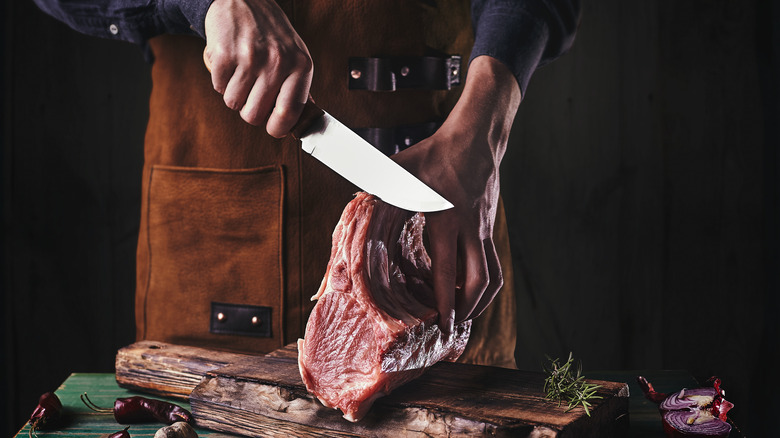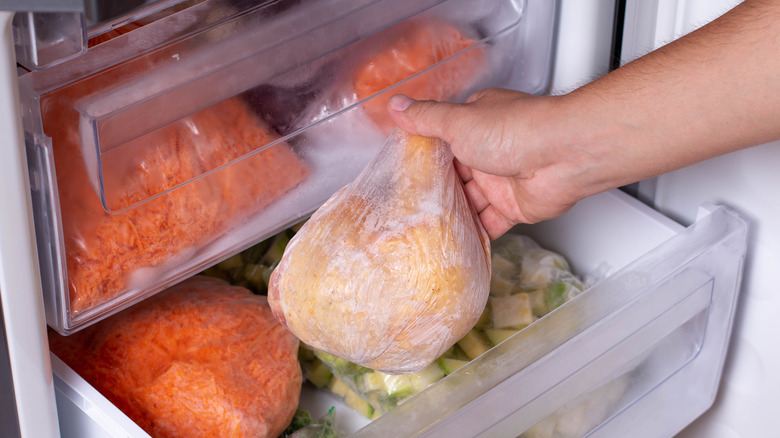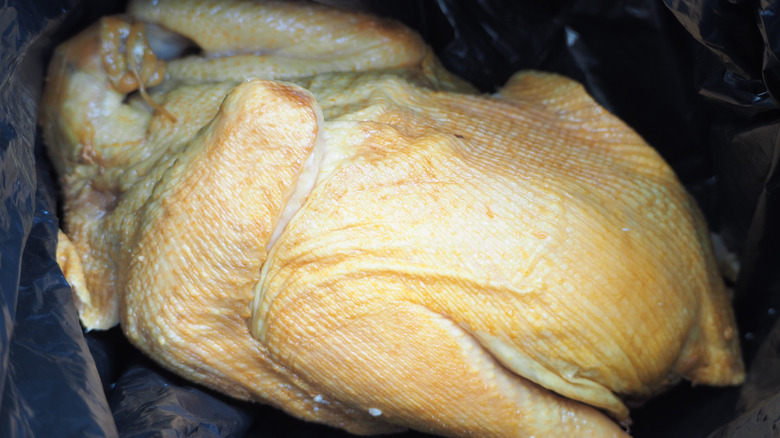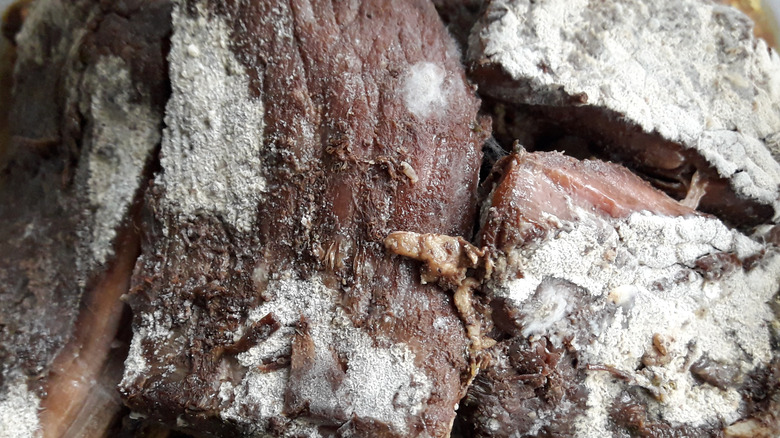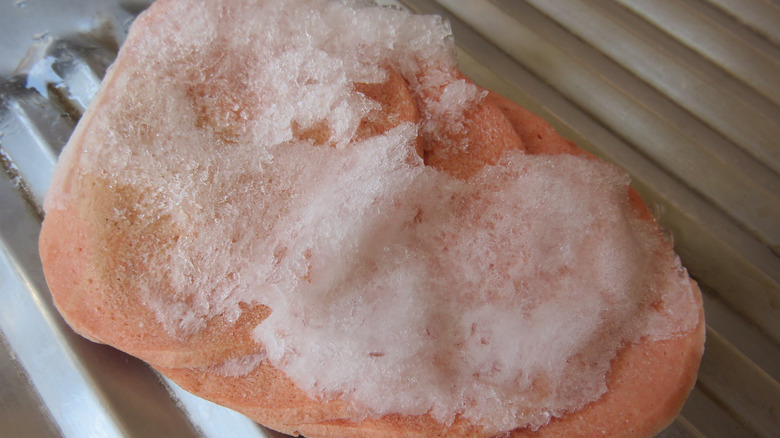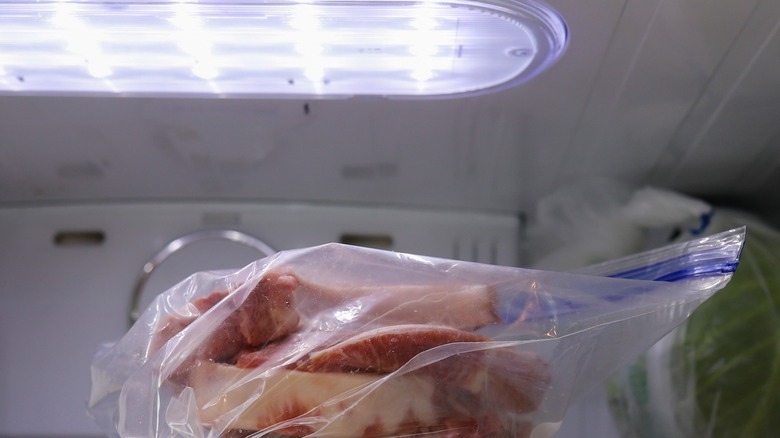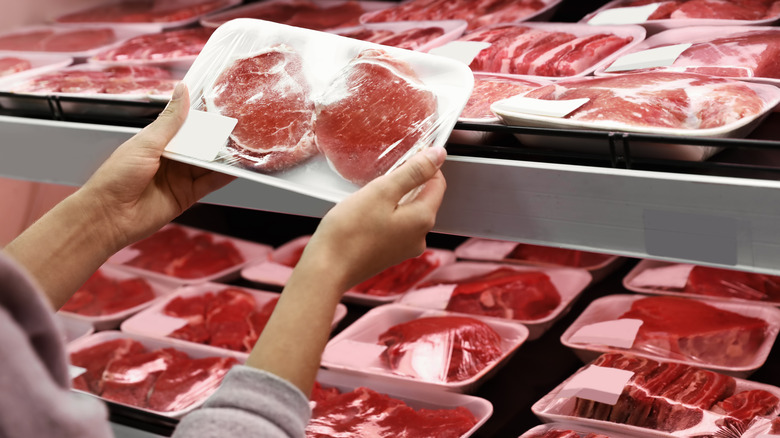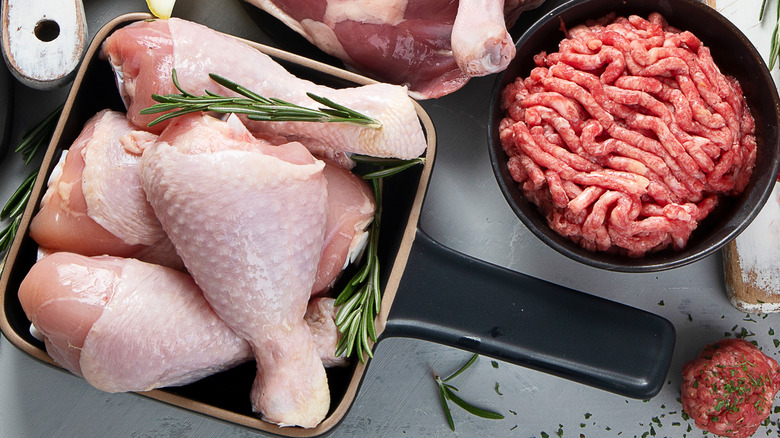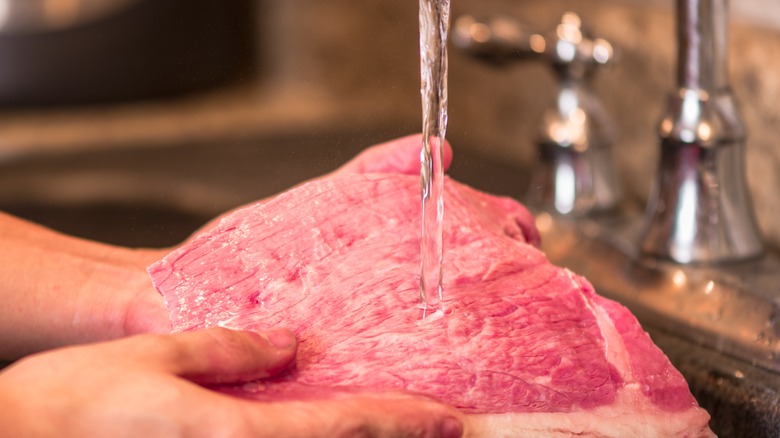How To Tell If Your Meat Is Spoiled
Protein is one of the five food groups necessary for a balanced meal. Meat is usually the go-to to fulfill that category, but serving spoiled meat will have people running from the dinner table to a nearby bathroom or even the worst-case scenario — driven to a hospital.
According to the National Health Service, food poisoning symptoms include vomiting, (bloody) diarrhea, stomach cramps, and a loss of appetite. These effects of eating spoiled meat can be noticeable within the first two days and can last up to four days to potentially a week. If you ever find yourself in a situation where you feel sick due to the consumption of spoiled meat, drink water to prevent dehydration, which can be caused by food poisoning symptoms.
Thankfully, there are many ways to inspect, identify, and prevent your meat from becoming the culprit of a horrendous food crime and determine if your meat is spoiled or not.
Check the expiration date
One of the simplest ways to determine if meat is spoiled is if the expiration date on the packaging has passed. Because products will include different types of dates on them, the American Heart Association explains what makes them different from each other.
The types of expiration dates are as follows: "Sell By," "Best By," and "Use By." The "Sell By" date is meant for store employees rather than customers. This is so those working at the store know when to remove products off of the shelves. Since everyone is human, workers can forget about removing expired products. Make sure to buy your meat before the "Sell By" date. As for the "Best By" date, it indicates when the best time is to use a product. If you want to impress others with a high-quality meat dish, you should cook it by the date included on the packaging. If you don't, you won't be serving spoiled meat, but the meat won't have the best flavor it could've had.
The "Use By" date is often mistaken for the previously mentioned labels. If you've purchased a meat product, you must cook it before the date. Eating meat after the "Use By" date can pose a threat to your health and others.
Do you smell anything?
Not only should you make sure your meat doesn't have a sour or tangy scent, but you should make sure it doesn't have a strong odor at all. Butcher Magazine reveals that fresh meat (and even fresh fish) lacks smell. If fresh meat is going to have any kind of smell, it would need to be red meat, which can have a faint bloody or metallic odor, notes Smoked BBQ Source.
The only exceptions to the smell test are ground pork and dry-aged meat. The Meritage Medical Network explains that even if ground pork doesn't have that noticeable stench, smell alone is not an indication of how safe it is to cook and eat because it can still have salmonella. As for the dry-aged steak, they can sometimes smell like cheese, notes Smoked BBQ Source, which doesn't mean that it's spoiled. It's important to not dictate if meat is spoiled or not based on one single factor.
Unusual texture
The texture is one of the easiest indicators of whether your meat is fresh or spoiled. LiveStrong describes fresh meat to be firm with little moisture, while spoiled meat feels sticky and as if it could slip out of your hands. Your meat should not be as slimy as a fish that was caught directly from the ocean.
In some other cases, the texture can be the opposite of slimy. Spoiled steak especially can feel very dry, notes Steak University. A common reason behind this odd consistency has to do with the steak losing its juices after being thawed. Although this may not always be an indication of a spoiled steak, this texture can guarantee it will have a lower-quality taste and be irritating to chew. Keeping steak in its package or within a compact sealing will be helpful for it and other kinds of meat to contain the appropriate amount of moisture and prevent spoilage from occurring faster.
Unpleasant taste
No one should willingly taste meat when there's potential for it to be spoiled. However, sometimes it's too late and you get a mouthful of cooked, but atrocious meat.
Oven Via clarifies that although cooking spoiled meat can kill germs, mold, and other kinds of bacteria, it's still not safe to eat as it will not get rid of harmful toxins. Spoiled meat can also contain spores, notes the National Library of Medicine, that are made from a mold and are capable of creating and spreading more bacteria. Cooking can make spores more of a threat as they are heat-resistant and heat is needed for them to reproduce germs. Although temperatures above 140 and under 160 degrees Fahrenheit are recommended for destroying spores, they can still survive, especially when spoiled meat has access to oxygen.
As a result, spoiled meat will taste exactly as it smells — sour or tangy. This is a reminder that if you consumed spoiled meat and feel sick, please go to a hospital right away.
Chicken spoils faster
Spoiled meat in general is a violation of our senses, whether it be how it smells, feels, or tastes. Although it seems like all kinds of meat spoil in the same way, the process in which they spoil works differently. Sometimes, some meat can spoil faster than others.
For example, Your Meat Guide revealed that raw chicken spoils the fastest in comparison to the rest of the meat section. This is because chickens continue to carry pathogens including salmonella, e-coli, and campylobacter from when they're processed and even when they were first slaughtered. Non-hygienic processes and locations can also contribute to the number of germs living in chickens. Another reason why chicken spoils faster than other meat is that the bacteria it includes can double every 20 minutes if it's exposed to too much moisture or within incredibly high temperatures outside of the frying pan or oven.
Discoloration
All spoiled meat will look moldy, slimy, and undergo some change in appearance. However, each type of meat will have a different color transition. Fresh chicken has a faint pink shade to it which turns white when properly cooked. If the chicken becomes spoiled, the color will turn gray and become more noticeable the longer it spoils.
As for the steak, it normally has a reddish color with a hint of purple. Fresh steak is usually brown and pink after it's cooked, and some steak will be more brown or pink than others depending on how the carnivore wants it cooked. On another note, if you see that your steak is brown before you cook it, that's a sign that it's become spoiled due to oxidation. If the steak turns yellow or green, that is a visual indication of spoilage and is likely to be moldy if it also has a film on it.
Although ground beef and steak come from the same species, unlike steak, a brown or sometimes grayish color isn't always an indication that it's spoiled, notes Insider. Ground beef can have its color changed due to freezing, which will not make it spoiled. The brown or gray color accompanied by mold will confirm any suspicions of spoilage.
How long has it been in your freezer?
Freezing and refrigerating meat are one of the most effective ways to prevent it from spoiling too fast. With that being said, different kinds of meat will need to be frozen and refrigerated for longer or shorter amounts of time than others. The American Heart Association says all meat must be kept at a temperature of 40 degrees Fahrenheit or lower for refrigeration, and 0 degrees Fahrenheit or below for freezing. They also demonstrate how long the process should be for every variety of meat to avoid spoiling and freezer burn (also, never store your meat in the fridge door).
Fish, ground beef, turkey, veal, pork, lamb, and chicken must be refrigerated for one-to-two days. Steaks along with any kind of meat sold as a chop or roast need to be refrigerated for three-to-five days. They also can be stored in a freezer for four-to-12 months. Pieces of chicken and turkey can be frozen for nine months, while a whole chicken or turkey can be frozen for up to an entire year. Fish can be kept in the freezer for three-to-eight months while the rest can be frozen only for three-to-four months. Not following these guidelines could be a factor in why your meat in the refrigerator or freezer is spoiled.
Is there cross-contamination?
Cross-contamination is when bacteria from one food item transfers to another and can be especially dangerous when there's meat involved. FoodDocs mentions some of the most common ways you can cross-contaminate, which include storing raw and cooked food on the same shelf in a freezer and refrigerator. Because raw meat can carry a lot of pathogens due to the way it's processed, those germs can easily spread to anything it has contact with or close to. Since cooking meat will get rid of the majority of bacteria from when it was raw, it's very counterproductive to place anything next to raw meat because it will regain that bacteria and spoil.
Cross-contamination can also occur when storing leftover meat with cooked meat you put in the refrigerator for the first time. Similar to raw meat, leftover meat can also contain a large number of bacteria that will cause itself and recently cooked meat to both spoil. It's important to make sure while you're trying to prevent meat spoilage by refrigerating it for the appropriate amount of time, you also need to keep track of other products you have on the same shelf with it.
Incorrectly thawing the meat
After freezing your meat for the correct amount of time, there still could be a chance of meat spoilage depending on how it's thawed.
Raw meat always needs to be in a cold area or else the heat of the kitchen will cause your meat to spoil and get out of it. Instead of thawing meat on your kitchen counter, thaw it in your refrigerator. You can also place it in a secure, leak-proof plastic bag and submerge it in cold tap water. If you see any damage to the meat's tissue, this is because the packaging of the meat or plastic bag has holes in it. This is an indication of meat spoilage as direct contact with the cold water leads to it being infected by bacteria.
Similar to how you can spoil meat if you're not applying the correct amount of time on freezing or refrigerating, the same applies to thawing. The U.S. Department of Agriculture explains that one pound of meat and small packages can thaw within an hour or less while larger packages will need about two or three hours. Whole turkey, for example, will need 30 minutes per pound to successfully thaw so make sure you weigh your meat before beginning this process.
Is there mold or physical damage?
According to MadgeTech, three main ingredients are the recipe for spoiled meat — microorganisms, chemical changes, and physical damage.
Microorganisms can be found within bacteria and mold. Although microorganisms aren't inherently harmful, they can be if they're exposed to moisture, which then leads to contamination. If you store meat within the range of 40-to-140 degrees Fahrenheit, that will make microorganisms more dangerous as they will multiply faster and create toxins. A few examples of this include clostridium perfringens which are identified in uncooked meat and Bacillus cereus which is one of the most common causes of food poisoning since it lives in spoiled meat and other organic foods.
It's important to look out for physical damage to meat and its packaging before purchasing. If there are cracks in the meat or the package is broken there's a risk of the meat becoming spoiled before its expiration date. Keep in mind that although freezing helps prevent spoilage, freezing too much can cause the meat to crack.
Pay special attention to hazardous meats
It's important to prevent any kind of meat from getting spoiled, but some types are likely to contain more pathogens than others. The Center for Science in the Public Interest revealed in 2013 that chicken and ground beef are the most hazardous meats. This is because salmonella is the most common cause of food poisoning due to the consumption of raw and spoiled chicken and ground beef.
Besides salmonella, campylobacter is another leading cause of food poisoning from chicken. Campylobacter can cause similar reactions as salmonella and is most likely to cause diseases in the summer. The bottom line is that the types of meat that are more likely to be contaminated are more dangerous when they become spoiled. Make sure to look out for mold or unusual substances on chicken and ground beef especially as it will be more likely to cause severe illness.
Did you wash it?
No matter how hard you try to make a meal out of spoiled meat, cleaning it will never make it less dangerous to serve and eat. If you wash your meat, you've increased the chances of getting someone sick. The Washington State Department of Health provided evidence against the claim that washing meat will diminish harmful bacteria.
When you wash or rinse meat, it's considered to be another form of cross-contamination as the bacteria will spread to anything in the area that has contact with it and the water. It's already unsanitary to rinse raw meat, so if you wash spoiled meat, that will spread harmful bacteria and toxins to many of your other ingredients and even utensils. Washing meat isn't worth it and it's better to say goodbye to one ingredient rather than a whole shelf in your refrigerator. No matter how you try identifying how your meat is spoiled, never let it spoil your meal.
